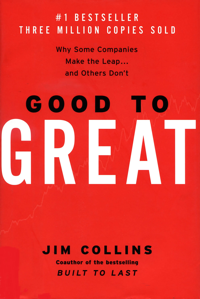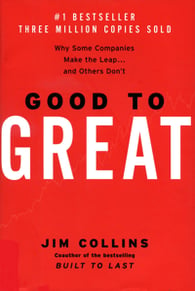Sales Organisations: from Good to Great
November 8, 2016

 Jim Collins “Good to Great” has been the inspiration for many CEOs who are determined to elevate their companies from run-of-the-mill to lasting greatness. There are many lessons to be learned from the book, but one of the most significant is the idea that before organisations can stand a chance of realising their potential, they must get the right people on the bus, the wrong people off the bus, and get the right people in the right seats.
Jim Collins “Good to Great” has been the inspiration for many CEOs who are determined to elevate their companies from run-of-the-mill to lasting greatness. There are many lessons to be learned from the book, but one of the most significant is the idea that before organisations can stand a chance of realising their potential, they must get the right people on the bus, the wrong people off the bus, and get the right people in the right seats.
This concept holds true for every department, but the principles have particular relevance for companies seeking to build an excellent sales organisation that is capable of significant, scalable growth whilst delivering reliable revenue performance every quarter along the way.
Making bad hires or failing to address personnel issues has a particular impact on the sales function. In organisations with complex or lengthy sales cycles the knock-on impact of bad recruiting or the acceptance of poor performance can resonate for multiple quarters - and cause sales leaders to lose their jobs...
EXPERIENCE ISN'T ENOUGH
Markets and buyer expectations are evolving so fast that we cannot rely on experience as the primary factor in recruitment decisions. Attitude, aptitude, adaptability, curiosity, cultural fit and the capacity for continuous learning have become far more effective predictors of long-term sales success.
If we are to recruit the right sales people onto our sales bus, then we need to assess their character as well as their claims of accomplishment. We need to judge whether they are likely to fit in to our environment, and whether they have a powerful internal commitment to continual personal development that is not dependent on how many training courses we end up paying to send them on.
My observations suggest that the more people candidates interact with during the interview process, the better - including their potential peers. The more we test what they are capable of actually doing, rather than saying, the better - through realistic role plays and scenarios. Conducting formal role based psychographic sales assessments can also make an important contribution.
A 360° PERSPECTIVE
But what really seems to matter is taking the time, combining all the inputs to get a complete 360° view of the candidate, and involving multiple people in the decision. It’s expensive in time and resources. But the cost of a bad sales hire is far higher. Recruitment is hard: I’ve learned that it’s critical that we take the process seriously, set the bar high, and refuse to accept sub-standard hires.
Which then leads to the question of where we stand with regard to existing members of the sales team. Were they in retrospect the right people in the first place (would we hire them again?), are they still the right people, and are they in the right seats - from the perspective of both their potential contribution to the organisation and their personal development goals?
Just as in recruitment, attitude, aptitude, adaptability, curiosity, cultural fit and the capacity for continuous learning are the key indicators of whether any individual has the potential to do better than they currently are. But they are also the factors that tend to be innate and hardest to change.
DIFFICULT DECISIONS
It can lead to some tough conversations, but we cannot afford not to confront these issues. We need to give able people who are willing the chance to improve. We may need to accept that we have failed them and that we need to do more to enable them to realise their potential. But both in recruiting new talent and managing the existing team, ensuring we always have the right people on the bus in the right seats is one of every sales leader’s most critical responsibilities.
We can’t ignore how easy or difficult it is to manage each individual. Our chances to change behaviour are highest where people are open and responsive to fresh ideas and keen to learn. Conversely, we can all probably reflect on the frustrations of trying to manage someone who refuses to see the need for change, and may even overtly or covertly rebel against it.
Organisations typically only tolerate these “lone wolves” for as long as they deliver their numbers. But even that tolerance may be misplaced. If these mavericks cannot see how the world is changing around them, it’s only a matter of time before their luck will inevitably fail - and let’s not forget that their impact on the rest of the team can often (but not always) be corrosive.
Having observed a few of these situations over the years, I’ve concluded that attitude and aptitude problems have to be confronted, even if sales performance appears to be currently satisfactory. If attitude and aptitude show promise, it’s worth investing time to see how the individual can be developed and whether they would do better in another seat on the sales bus.
LEARN FROM THE BEST - AND LET THE WOLVES GO
Understanding what makes your role-model top performers tick, and systematically sharing their best practices with the rest of the sales organisation can be tremendously productive, and is usually welcomed with open arms by sales people who are willing to learn and committed to continual personal development.
As far as the “lone wolves” are concerned, you need to make it clear that their performance is assessed not just in terms of their personal revenue numbers, but the way in which their results are achieved and their contribution to both the satisfaction of the customer and the well-being of the sales team as a whole.
These conversations needs to take place, and they can’t be informal: they needs to be clearly documented and deviations from expected behaviour recorded and reviewed, because you may need this information to justify a conclusion that the individual no longer has a role to play in your future sales organisation.
Some sales leaders take the view that “lone wolves” are incapable of changing their spots (to mix a carnivore metaphor), but I believe that it’s worth at least one honest attempt to help them recognise the need to for change, and to support them in achieving it. But there need to be limits to our tolerance.
In the long run, excellent sales organisations are built from smart individuals in appropriate roles, in a supportive environment in which the whole team learns and develops together. So - when you think about your sales organisation today, and your ambitions for the future: do you have the right people on the bus in the right seats? And what are you doing about the people that will only hold the bus back if they remain on it?
ABOUT THE AUTHOR
Bob Apollo is a Fellow of the Association of Professional Sales and the Founder of UK-based Inflexion-Point Strategy Partners, the B2B sales process consultants. Following a successful corporate career spanning start-ups to established corporates, Bob now works with a growing client base of B2B-focused growth-phase technology companies, helping them to implement structured selling systems that drive predictable revenue growth.
YOU MIGHT ALSO LIKE
- 10 Tell-Tale Signs That Your Sales Process Could Benefit From Some Attention
- A Simple Guide to Compelling Messaging for the Complex Sale
- ADOPTED: A Structured Approach to Opportunity Qualification for the Complex Sale
A previous version of this article was published on CustomerThink.


Comments